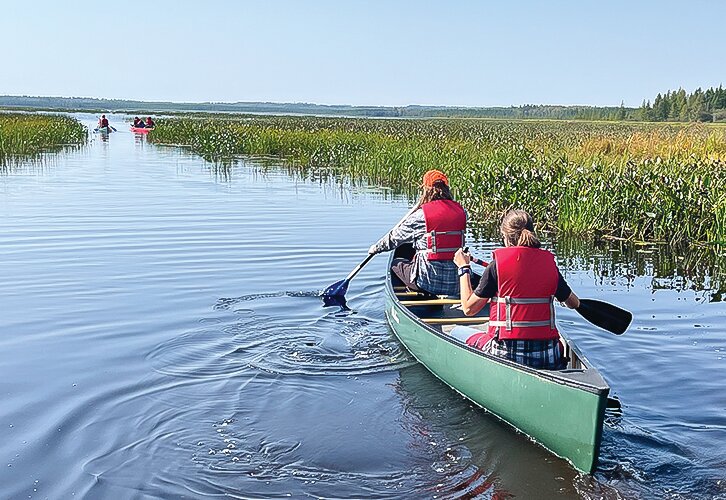Support the Timberjay by making a donation.
Weaving culture, science, and history
TOWER- An all-school field trip to Big Rice Lake in late September was just the starting point for a multi-disciplinary approach to studying the cultural, scientific, and historical roots of our region for students at Vermilion Country School in Tower.
During the all-day trip, organized with help from the 1854 Treaty Authority and the Minnesota DNR, students had a chance to paddle a canoe on the lake and see wild rice growing. They learned how to parch and thrash rice, and had time to hike in the woods, and then shared a lunch cooked over a campfire.
But the day was only the start of the study of manoomin, the Ojibwe word for wild rice.
Teachers are using wild rice as a focal point for science, history, and environmental studies this fall, with a focus on hands-on, project-based learning. Students will be able to use some of their fall projects as part of the year-end environmental expo, which highlights the environmental learning done throughout the year.
Adrienne Whiteman, the school’s director of Indigenous Programming, is excited to see all the ways the study of wild rice fits into the school’s curriculum, for both the Native American students and the entire student body.
“We are all learning as a group,” she said. Some students were uncertain about trying new experiences, like parching rice in an iron kettle over an open fire.
“But we helped talk them through the process,” she said. “Overall, it’s been such a good experience.”
She noted that some of the Native students have not had the chance to learn these traditions from their own families, so it is as new to them as other students.
“I am so happy for the willingness of our teachers to be on one page for this,” she said.
About one-third of the students at VCS are Native Americans, and many live on the Vermilion and Nett Lake reservations.
“Once a week we are doing lessons on wild rice,” said science teacher Sam Magnuson, with units already looking at the life cycle, phenology, and conservation challenges for those managing wild rice lakes. Students will be exploring the differences between commercially-grown “paddy” rice and authentic wild rice, and later this fall will be exploring different recipes that feature the native grass.
Students in U.S. History are learning about the history of manoomin and its importance to the cultural identity of the Native Americans from before white settlement to the present day. They have been studying the history of tribes in the northeast portion of the United States and their relationships to manoomin.
“We want to create a compassionate understanding for where our students live,” said Magnuson. “This is place-based education, giving students a great sense of ownership of their learning by tying it to their community.” Students are also being encouraged to interview their own family members to learn about their experiences harvesting wild rice.
Jackie Ridings, the school’s student success counselor, is working with students to understand misconceptions about the history of the grain and its importance to cultural identity.
“Our food systems today do not honor that,” she said.
“What does wild rice bring to our communities then (back in the 1600s) and now,” she asked. “And what is it still providing.”
Students are studying the science behind wild rice management, and how it differs from other crops.
“This is such an interesting crop,” Magnuson said. “In alternative, more “natural” agriculture you want diverse stands. But wild rice grows best in a monoculture.” Human interference, invasive species and pickerel weed, and climate change are all proving dangerous to the future of wild rice.
“When we make land management decisions, we need to start with science first,” he said. “But we need a foundational knowledge. This was built up over thousands of years, but current land managers didn’t listen and learn.” Efforts to manage wild rice by managing water levels have proven problematic. In addition, the crop is sensitive to weather and to changing water levels.
“When you take from the earth, you have to give back,” said Ridings. “What happens if we destroy the water source? We are destroying our future.”
The school is developing its own curriculum this year, with help from resources including the 1854 Treaty Authority, with help from staffer Marne Kaeske.
“Marne loves to include students in all aspects of traditional hunting and gathering,” Whiteman said. “The school’s ability to collaborate with 1854 really benefits our students.”
Whiteman is heading an effort to develop a wider curriculum, including Ojibwe language lessons and other Native crafts. For Indigenous People’s Day on Oct. 14, students will get the chance to learn birch bark basket weaving, beading, and making lanyards.
The school will also be partnering with the Bois Forte Heritage Center for both tours and more in-depth learning, Whiteman said.
The 1854 Treaty Authority is an inter-tribal natural resource management organization that protects and implements the off-reservation hunting, fishing and gathering rights for the Grand Portage and Bois Forte bands in the lands ceded to the United States government under the Treaty of La Pointe, 1854.











